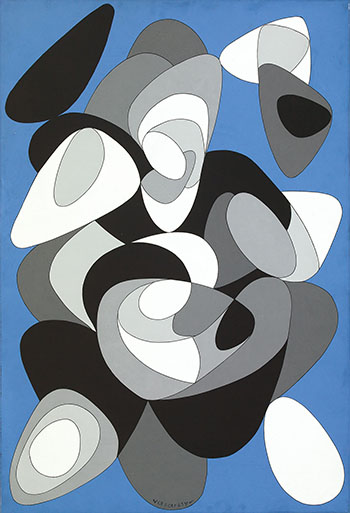EXHIBITED:
Taiwan's Treasures: Western Art from Private Collections,
Taipei Fine Arts Museum, Taipei, October 6 - December 2,
2001
ILLUSTRATED:
Taiwan's Treasures: Western Art from Private Collections ,
Taipei Fine Arts Museum, Taipei, 2001, color illustrated,
p. 108
Catalogue Note:
VICTOR VASARELY, THE "FATHER" OF THE OP ART MOVEMENT
THE TERM "OP ART" (OPTICAL ART) DERIVES FROM THE EXHIBITION "THE RESPONSIVE EYE" THAT WAS HELD AT THE MUSEUM OF MODERN ART IN NEW YORK IN 1965, WHICH WAS THE FIRST LARGE-SCALE EXHIBITION TO PRESENT TO THE PUBLIC THIS NEW FORM OF ART, FEATURING PRECISE COMPOSITIONS BASED ON THE USE OF SCIENTIFIC METHODS TO ANALYZE COLOR, AND ON COMPLEX NUMERICAL CALCULATIONS; WORKS WHICH, WHEN VIEWED BY THE NAKED EYE, OFTEN CREATE OPTICAL ILLUSIONS OR A SENSE OF MOVEMENT. FOLLOWING THIS EXHIBITION, VICTOR VASARELY CAME TO BE UNIVERSALLY ACCLAIMED AS THE "FATHER OF OP ART."
Vasarely had in fact begun to create the beginnings of this movement, one of the most influential art movements of the 20th century, around 30 years previously. Born in Hungary in 1906, Victor Vasarely enrolled in the department of medicine at Eötvös Loránd University in Budapest in 1925. Two years later, he decided to heed his calling to make art his career, and began academic art training. Vasarely’s medical training had instilled in him a markedly scientific approach, a commitment to objectivity, and an unslakeable thirst for knowledge. In 1929, Vasarely enrolled in the Mühely, an art school known as "Budapest’s Bauhaus," where he was exposed to the work and theories of Malevitch and Kandinsky. He moved to Paris in 1930
Zebra, a monochrome painting that Vasarely created in 1938 (when he was 32), is generally considered to be the first Op Art work ever produced. The image is created from a pattern of rippling stripes, with no outline. With its perfectly juxtaposed contrast, the painting shows how simple lines can give two-dimensional space a sense of movement and dynamism.
From 1947 onwards, Vasarely spent his summers on the island of Belle-Isle in Brittany and in the small town of Gordes in the south of France. He would walk by the sea, enjoying the beautiful views and bright sunlight. "Belle-Isle, summer 1947. The pebbles, the seashells on the beach, the whirlpools, the hovering mist, the sunshine, the sky… in the rocks, in the pieces of broken bottles, polished by the rhythmic coming and going of the waves, I am certain to recognize the internal geometry of nature…" The "Belle- Isle Period" extending from 1947 to 1958 was a watershed in Vasarely’s artistic development. This was the period that marked his embarkment on abstract painting, with the utilization of simple geometric forms to represent the natural world, particularly ovals, which Vasarely used to symbolize "the oceanic sentiment".
Inspiration taken from the curious drawings of the cracked white tile walls of the Denfert-Rochereau metro station in Paris, and from the changes in the play of light and shadow on the walled town of Gordes, gradually led Vasarely’s art in the direction of a more abstract, more geometrical world. In Vasarely’s "Black and White Period" (1950-1965), he adopted revolutionary new techniques that laid the foundations for the subsequent development of the Kinetic Art and Op Art movements. The intermeshing of black and white in Vasarely’s works from this period created an undulating effect; twodimensional images were no longer static, and could create optical illusions, taking art, science and visual experience into a whole new world. And all of this was taking place at a time when computers were still only in the early stages of their development!
Vasarely received numerous awards, including the Brussels Art Critics Prize, a Gold Medal at the Milan Triennial, and the Guggenheim Prize. His international reputation reached its apogee following the holding of the "The Responsive Eye" exhibition at the Museum of Modern Art in New York in 1965. In 1970, Vasarely was made a Chevalier of the Légion d’honneur by the French government. Many exhibitions of his work were held, and his pieces were avidly collected by major art museums all over the world. Today, the influence of Op Art can still be seen in advertising, architecture, design, fashion, and digital images.
Meaning "the vast sea" in Hungarian, the language of his homeland, "Tenger" is regarded as a representative work of Vasarely’s "Belle-Isle Period". With azure as the background, the artist put black, white and gray ovals on his canvas, where they appear like pebbles washing back and forth toward the shore by the sea water, or a vortex rotating lightly between the waves. A simple composition of color and shapes is enough to express the rhythm and imagery of nature. Vasarely once again amazes his viewers with his precise grasp of all things in sight!
